More than 300 species of birds consume fish. Among them are: kingfishers, penguins, pelicans, cormorants, herons, egrets, sea eagles, and storks are commonly eat sea fishes. While the fish eating birds like osprey, geese, ducks, and swans rely on ponds to hunt their prey.
The bird is the most beautiful and blissful creature in the world and it is an unavoidable truth. Some said birds are the “Litmus of Nature”. Birds are a group of warm-blooded vertebrates constituting the class Aves, characterized by feathers, toothless beaked jaws, the laying of hard-shelled eggs, a high metabolic rate, a four-chambered heart, and a strong yet lightweight skeleton.
Some of these birds have adapted to their aquatic habitats, and many species have developed unique physical characteristics and behaviors that allow them to thrive in this environment.
Some birds, such as ospreys, have special adaptations that help them catch fish, such as webbed feet and sharp talons. Fish are an important part of these birds’ diets, and they can consume large quantities of fish each day.
List of Birds That Eats Fish in Ponds and Sea

Different birds have different food habits. Some of them are piscivorous. The piscivorous birds, such as ospreys, pelicans, and kingfishers, hover, soar, or perch above the water to catch fish, then plunge into the air to retrieve their prey.
| 1 | Albatross |
| 2 | Pelican |
| 3 | Osprey |
| 4 | Great blue heron |
| 5 | Penguin |
| 6 | Bald eagle |
| 7 | Great Egret |
| 8 | Belted Kingfisher |
| 9 | Great cormorant |
| 10 | Common tern (Sternidae) |
| 11 | Atlantic puffin |
| 12 | Anhinga (snakebird) |
| 13 | Black Guillemot |
| 14 | Black Skimmer |
| 15 | Turkey Vulture |
| 16 | Stellar’s Sea Eagle |
| 17 | Ruddy Turnstone |
| 18 | Pied-Billed Grebe |
| 19 | Seagull |
| 20 | Puffin (Sea Parrot) |
| 21 | Gannet |
| 22 | Swallows |
| 23 | Loons |
| 24 | Stork |
| 25 | Crane (bird) |
| 26 | Common murre |
| 27 | American dipper |
| 28 | Black-faced spoonbill |
| 29 | Great kiskadee |
| 30 | Pigeon guillemot |
| 31 | Snowy egret |
| 32 | Australasian Gannet |
| 33 | Canvasback |
| 34 | Indian Spotted Eagle |
| 35 | Peregrine Falcon |
| 36 | Snowy Owl |
| 38 | Northern Goshawk |
1. Albatross
Scientific name: Diomedeidae
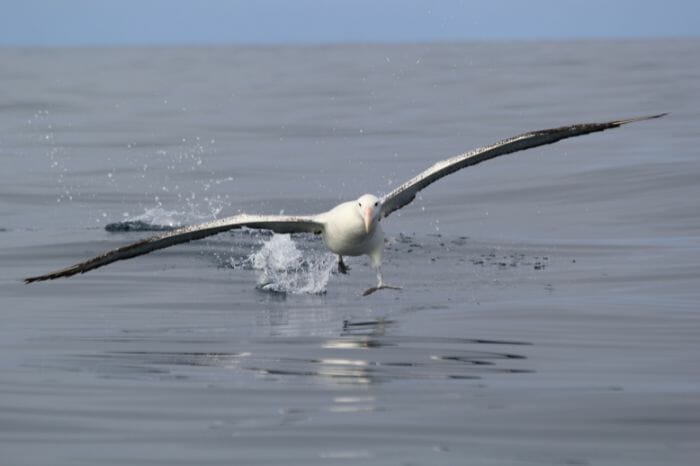
Albatrosses are highly efficient in the air, using dynamic soaring and slope soaring to cover great distances with little exertion. They feed on squid, fish, and krill by either scavenging, surface seizing, or diving.
Albatrosses are among the largest flying birds, and species of the genus Diomedea (great albatrosses) have the longest wingspans of any extant birds, reaching up to 3.7 m (12 ft). They range widely in the Southern Ocean and the North Pacific.
The favorite foods of albatrosses include fish and squid.
2. Pelican
Scientific name: Pelecanus
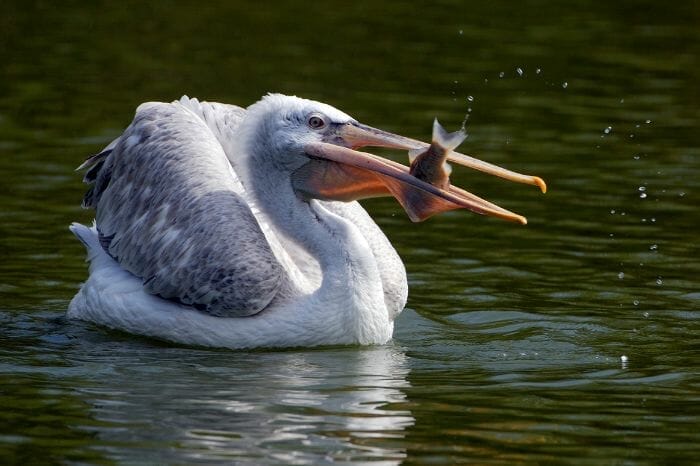
A pelican is a type of large water bird. It catches fish and keeps them in the bottom part of its beak which is shaped like a large bag.
They are among the heaviest of flying birds. Males are generally larger than females and have longer bills. The smallest species is the brown pelican, a small individual which can be no more than 2.75 kg (6.1 lb) and 1.06 m (3.5 ft) long, with a wingspan of as little as 1.83 m (6.0 ft). The largest is believed to be the Dalmatian, at up to 15 kg (33 lb) and 1.83 m (6.0 ft) in length, with a maximum wingspan of 3 m (9.8 ft).
Pelicans are found on many of the world’s coastlines and also along lakes and rivers. Although their native range includes the Atlantic, Pacific, and Gulf coasts.
Their favorite food is fish, but occasionally amphibians, turtles, crustaceans, insects, birds, and small mammals.
3. Osprey
Scientific name: Pandion haliaetus
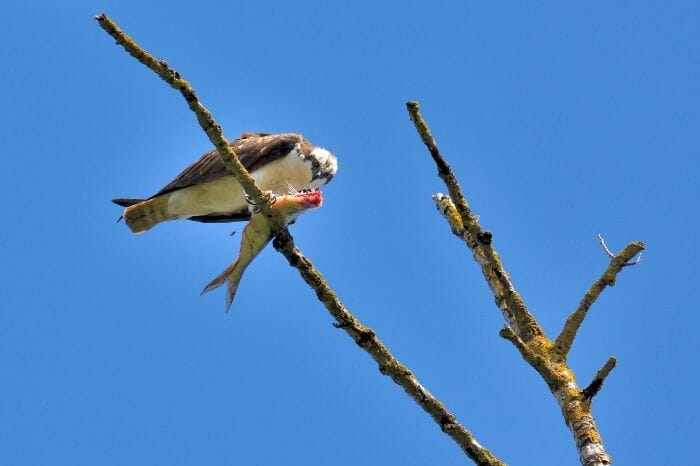
Osprey is also called sea hawk, river hawk, and fish hawk. Despite their size, their bodies are sleek, with long, narrow wings and long legs.
Osprey is known to eat fish in ponds. In fact, they only live on fish.
It is a large raptor reaching more than 60 cm (24 in) in length and 180 cm (71 in) across the wings. It is brown on the upper parts of the body and predominantly greyish on the head and underparts. Ospreys are migratory, the majority wintering south of the US border.
Typically 5-16 inches fishes are the first choice of them. Osprey eats small mammals, birds, or reptiles when fishes are not available.
4. Great blue heron
Scientific name: Ardea herodias
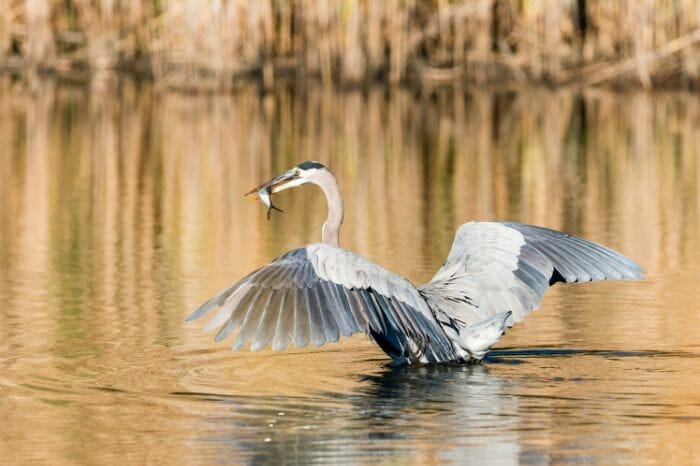
The great blue heron is a large wading bird in the heron family and is the largest wading bird in North America.
males slightly larger than females, but otherwise the sexes are not easily outwardly distinguishable. It has a head-to-tail length of 91–137 cm (36–54 in), a wingspan of 167–201 cm (66–79 in), a height of 115–138 cm (45–54 in), and a weight of 1.82–3.6 kg (4.0–7.9 lb).
The great blue heron is found throughout most of North America, Alaska, and the southern Canadian provinces in the summer. In winter, the range extends south through Florida, Mexico, and the Caribbean to South America.
Eats mostly fish, but also frogs, salamanders, turtles, snakes, insects, rodents, and birds.
5. Penguin
Scientific name: Spheniscidae
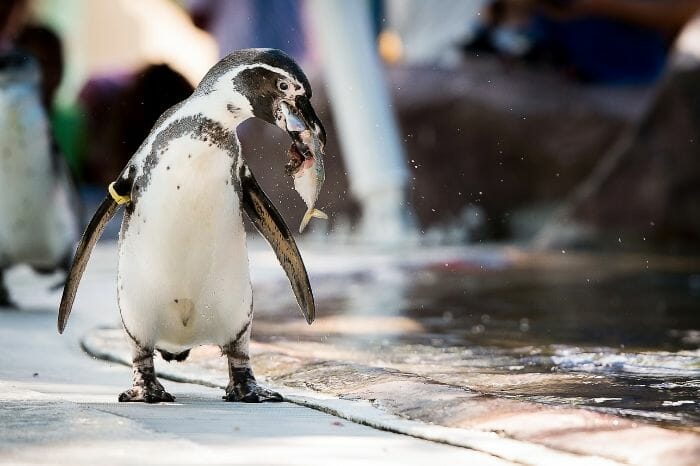
Though they are flightless birds we can’t imagine a world without Penguins.
Penguins vary in size and weight depending on the species. Their height ranges from 15 inches to 3.5 feet. Their weight ranges from 2 pounds to 88 pounds.
penguin species are native to the Southern Hemisphere. Major populations of penguins are found in Angola, Antarctica, Argentina, Australia, Chile, Namibia, New Zealand, and South Africa
Their favorite food is small fish, including anchovies, sardines, and sprats of most penguin species’ diet.
6. Bald eagle
Scientific name: Haliaeetus leucocephalus

Adult Bald Eagles have white heads and tails. It has dark brown bodies and wings with bright yellow legs and bills.
They are found only in North America. Their range stretches from far northern Canada and Alaska down to northern Mexico.
The bald eagle has a body length of 70–102 cm (28–40 in). Typical wingspan is between 1.8 and 2.3 m (5 ft 11 in and 7 ft 7 in) and mass is normally between 3 and 6.3 kg (6.6 and 13.9 lb). Females are about 25% larger than males, averaging as much as 5.6 kg (12 lb), against the males’ average weight of 4.1 kg (9.0 lb).
Bald eagle nests are often very large to compensate for the size of the birds. The largest recorded nest was found in Florida in 1963 and was measured at nearly 10 feet wide and 20 feet deep.
Though fish is the primary food of bald eagles, Their prey items include waterfowl, small mammals like squirrels, prairie dogs, raccoons, and rabbits.
7. Great Egret
Scientific name: Ardea alba

Look like their names! Its dazzling looks can catch anyone’s eyes in one second.
Found in Asia, Africa, the Americas, and southern Europe.
This species can measure 80 to 104 cm (31 to 41 in) in length and have a wingspan of 131 to 170 cm (52 to 67 in). Body mass can range from 700 to 1,500 g (1.5 to 3.3 lb).
Fish is an ultimate favorite. Aside from fish, frogs, salamanders, snakes, and insects are also on the list.
8. Belted Kingfisher
Scientific name: Megaceryle alcyon
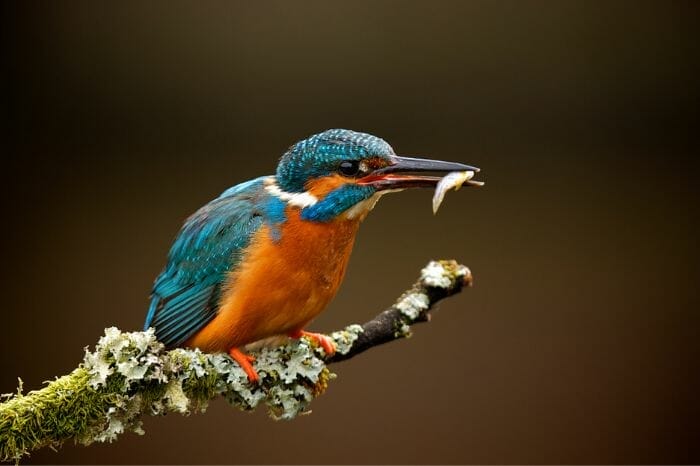
The Belted Kingfisher is a very handsome medium-sized bird. A large, crested head gives a royal look, and also had a long, solid bill. If you wish to make a list of birds that eat fish, there is no way to skip this beautiful creature.
They are 28–35 cm (11–14 in) in length with a wingspan of between 48–58 cm (19–23 in). This kingfisher can consider from 113 to 178 g (4.0 to 6.3 oz). The adult female averages are slightly larger than the adult male.
Found near streams, rivers, ponds, and lakes. They are native to North America, also seen in Greenland and Canada.
They mostly eat small fish, insects, frogs, mollusks, crustaceans, amphibians, and lizards.
9. Great cormorant
Scientific name: Phalacrocorax carbo
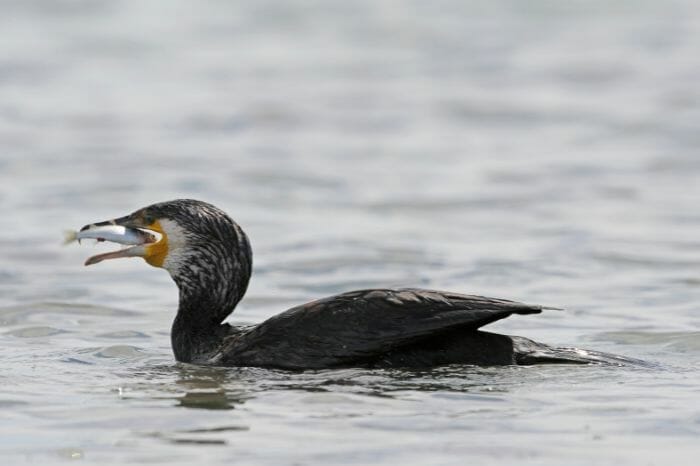
The Great cormorant is a bird that breeds in tundra areas from Alaska and Canada to northern Eurasia. It nests on the ground near lakes, rivers, and streams. It eats fish, crustaceans, and amphibians.
Great cormorants build large nests of sticks and mud, which are often situated over water. The nests are built on top of platforms above water. In the winter, Great cormorants migrate south.
10. Common tern (Sternidae)
Scientific name: Sterna hirundo
Sterna hirundo is a seabird in the family of Laridae. The tern is a seabird known for its black and white feathers. They are fairly large, but their short wings allow them to move quickly through the air. Their large eyes are susceptible to their surroundings, giving them the ability to detect prey. Their diet consists of fish, worms, crustaceans, and even garbage.
It is a seabird that can be found near coasts and inland waterways. The Common tern is a migratory bird, meaning that it will travel to different areas depending on the time of year. In the winter, the Common tern will travel to warmer climates, such as the Caribbean.
11. Atlantic puffin
Scientific name: Fratercula arctica
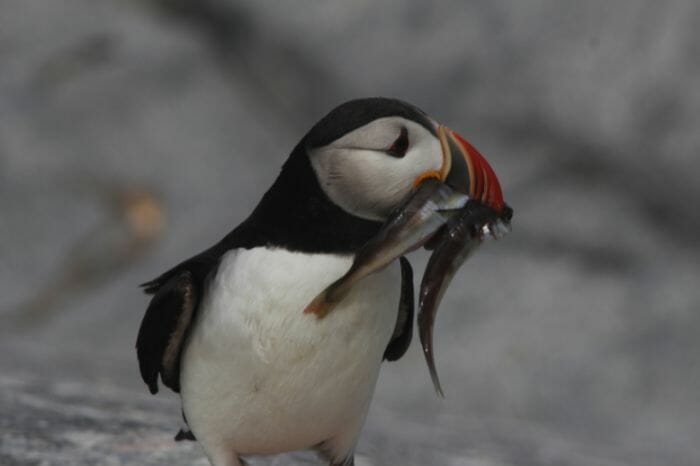
The Atlantic puffin, also called the clown puffin, is a chubby, black-headed bird with a white chest. The Atlantic puffin is a seabird that is well-known for its diet of small fish. The puffin has four different species. Atlantic puffins are about 26-29 cm (10.2-11.4 inches) tall and weigh between 320-480 grams (.71-1.06 pounds). All the way from France to the Gulf of Maine, it is found across a broad geographic area.
These birds are found along the coastlines of the Ocean and are a popular sight for birdwatchers. The Atlantic puffin is a small bird with a black back and white underparts. These birds have a distinctive orange beak that is used to help them catch their prey. Atlantic puffins spend most of their time at sea, only coming ashore to nest. These birds are social creatures and often travel in large flocks.
12. Anhinga (snakebird)
Scientific name: Anhinga anhinga
The Anhingas are large, slender waterbirds with long, fan-like tails that resemble the tails of turkeys. Anhinga is long-necked birds that are mostly black. There are greenish-black feathers and silvery streaks along the upper back and wings of adult male Anhingas. Immatures and females have pale tanned heads, necks, and breasts.
They dive to catch fish and swim underwater or along the ground. They are typically 30 inches in length. The anhinga is the only bird that can dive as deep as 200 – 300 feet.
13. Black Guillemot
Scientific name: Cepphus grylle
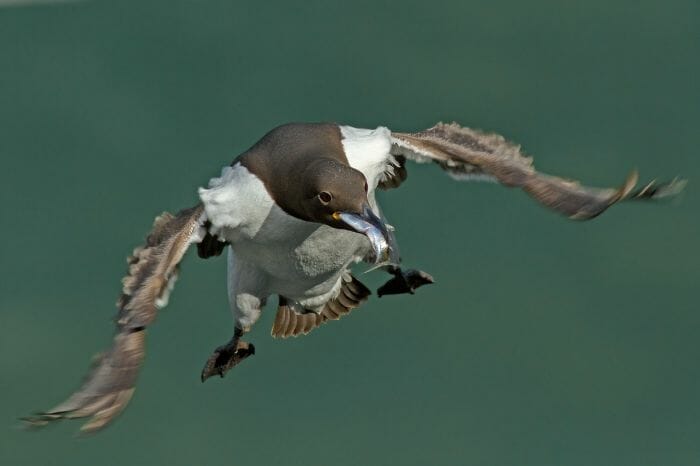
Black Guillemots are a type of sea bird and are named after their peculiar black plumage. They are rarely seen unless in the breeding season. They are plump, medium-sized animals with pointed tails and rounded wings.
They live in sea stacks or cliffs in the northwest, west, and northeast. Some of the frequent places where they are seen include Alaska, British Columbia, and New Jersey.
A guillemot’s diet varies according to season and location, but it generally consists of fish and crustaceans.
14. Black Skimmer
Scientific name: Rynchops niger
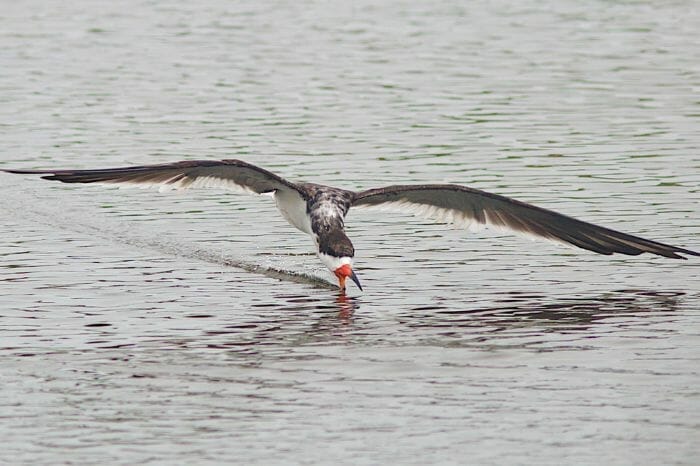
Black Guillemots are a type of sea bird and are named after their peculiar black plumage. They are rarely seen unless in the breeding season. They have short legs, sharp claws, long bills, and a long neck. They live in sea stacks or cliffs in the northwest, west, and northeast. In North America, Black Skimmers are usually found on sandbars and beaches. Some of the frequent places where they are seen include Alaska, British Columbia, and New Jersey.
This medium-sized tern-like seabird has very long wings and an outsized bill with a much larger lower mandible than an upper mandible. The bird flies low, plowing the water with its lower mandible and snapping its bill shut when it catches a fish.
Unusually long lower mandible compared with upper mandible of this tern-like bird. As it feeds, it stays close to the surface of the water and dips its lower mandible into it to catch small fish. Particularly found along beaches and sandbars. The barking of “yips” might give you a clue that a flock is in flight.
15. Turkey Vulture
Scientific name: Cathartes aura
Turkey vultures are scavengers that feed primarily on dead animals. They are mostly found in open grassland and open woodlands. They nest in trees, and like other vultures, fly in V-shapes while trailing long, curved tongues.
Unlike most birds, Turkey Vultures are large and heavy and have large, dark wings. In comparison with other raptors, they are much larger than condors and eagles. As they fly, their wings have longer “fingers” and their tails extend beyond their toes. When looking at them head-on, Turkey Vultures’ wings form a “V” when they fly.
16. Stellar’s Sea Eagle
Scientific name: Haliaeetus pelagicus

The Stellar Sea Eagle is an inflatable, semi-rigid craft designed for use in shallow waters and for recreation, as well as to support rescue operations and exploration.
The Steller’s sea eagle is a carnivore and scavenger that mainly eats salmon and trout. Their diet includes fish, crabs, shellfish, squid, small animals, ducks, gulls, and carrion.
17. Ruddy Turnstone
Scientific name: Arenaria interpres

The Ruddy Turnstone is a species of shorebird. This bird is a wader with light brown upper parts striped with black and grey. It has a white belly and a vent.
The Ruddy Turnstone also has an extensive range in North America, covering most of Canada, the northern United States, the northeastern United States, and scattered locations as far south as Texas and Mexico.
The species’ breeding habitat is a variety of habitats ranging from coastal beaches to inland wetlands and tundra, although it will commonly nest on or near beaches.
18. Pied Billed Grebe
Scientific name: Podilymbus podiceps
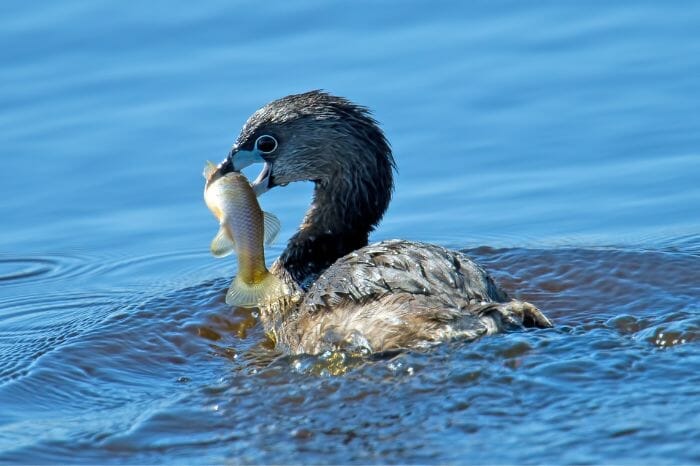
The Pied billed Grebe is a small, chunky bird that swims. They are known as the Pied-bill, which is a small duck, with a fairly large bill. There are several related species in the genus Podilymbus. In the genus Podilymbus, the Pied-Billed Grebe represents the sole species left because the Atitlán grebe is no longer extant.
Their bodies are compact, their necks are slender, and their heads are large, blocky, and their bills are long, thick, and short. Ponds across the Americas are the primary habitat of the pied-billed grebe.
19. Seagull
Scientific name: Larus argentatus
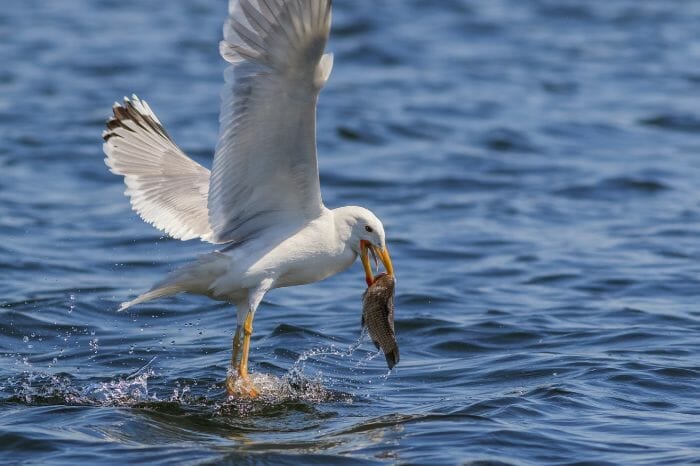
Seagulls, or gulls colloquially, are seabirds of the family Laridae. Their closest cousins are the terns and skimmers, and their closest relatives are the auks and waders. North and South America’s laughing gull is a medium-sized bird.
There are some superficial similarities between seagulls and eagles, such as the large body and hooked bill, but they are not regarded as predators. Unlike eagles which are related to kites and vultures, they are more closely related to auks, plovers, and other shorebirds.
Among the food items taken by gulls are fish, marine and freshwater invertebrates, both alive and dead, and arthropods on land. Furthermore, invertebrates such as insects, small rodents, bird eggs, carrion, small reptiles, amphibians, plants, garbage, chips, and even other birds contribute to the ecosystem.
20. Puffin (Sea Parrot)
Scientific name: Fratercula arctica

Puffins belong to the scientific family Alcidae. Puffins are divided into three species: common, horned, and tufted. The alcids, along with auks, guillemots, and murres, are still alive today.
A puffin’s colored beak earned it the name Sea Parrot. The Norwegian word for puffin is Lunde. Because they are so funny to watch, puffins are called clown birds. Puffins are known as Lundi in Icelandic.
The illusive Puffin spends days diving in cold waters and catching fish.


You May Also Read